4 min read 🤓
Trashing, un)un)un)educated
august 23, 2008.
Portable Noise Kremator is post-musician Wim van Gelder, from the village of Hoegaarden in Belgium, and former member of the experimental death-trash impro band ManGenerated, defunct since 2004. He keeps a blog, called the Noiseblog, that is both informative and entertaining.
This being the Soundblog, I wondered whether I should jump at the occasion and write some lines about the why and what of musics and sounds that are named noise ... Noise is a fascinating word, with a highly complex semantics. Writing a "Meaning of noise" might - nay, should ! - be the task of a lifetime, as it would undoubtedly lead one to re-consider much of our history. Does not noise stand to signal as a yin stands to a yang? It is part of any kind of communication, and it is communication through which we shape ourselves and our world. But then, should one ask, are we shaped through the signals, or rather shaped by the noise ? ... Several of you probably read Jacques Attali's Noise, Torsten Sangild wrote a short and interesting 'Aesthetics of Noise', a text that you should go and read over at ubuweb, and to which a follow-up 'Noise - three musical gestures' appeared in the spring 2004 issue of the Journal of Music and Meaning ... Somewhat more recent, there's Paul Hegarty's Noise/Music: A History, an attempt at tracing the history of noise in music from the early 18th century onwards way up to our japanese friend Merzbow and relating it to the writings of a handful of pretty much the usual suspects in (post-)modern philosophy ... Also fuzzy logician Bart Kosko, author of Fuzzy Thinking, wrote a book about Noise, exploring it in all of its color and glory : white, pink, brown, speckle, crackle and thermal, "to name just a few. Even chaos is a form of noise," I just read on the book's front flap ... All of these, I am sure, are but minute fragments of a far larger picture that still asks to be drawn...
"[N]oise needs a listener - probably some sort of animal or a non-organic
machine with hearing capacities," Hegarty writes on the very first
page of 'Noise/Music' ... 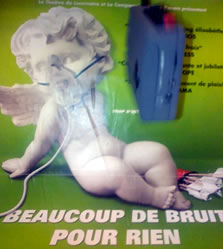 Like this text needs a reader- probably some sort of animal or a non-organic
machine with reading capacities ... It reminded me of the picture you see
to the left, that I shot for and together with Rien-us van Alebeek at the
Nation
metro station, on our way to w a r - or rather: to perform noisi-ly
at La Miroiterie - on july 17th. (More noising
about that soon, in the next entry ... you did know that to
noise (about) actually means 'to talk about', 'to make known publicly', didn't you?)
Like this text needs a reader- probably some sort of animal or a non-organic
machine with reading capacities ... It reminded me of the picture you see
to the left, that I shot for and together with Rien-us van Alebeek at the
Nation
metro station, on our way to w a r - or rather: to perform noisi-ly
at La Miroiterie - on july 17th. (More noising
about that soon, in the next entry ... you did know that to
noise (about) actually means 'to talk about', 'to make known publicly', didn't you?)
Apart from being a fine epithet for Rinus' ongoing curatorial efforts
at Das
Kleine Field Recordings Festival, Beaucoup de bruit pour Rien
also is the (or: a) french translation of Much
ado about nothing. A comprehensive philosophy of noise would surely
include Shakespeare's work. "I use the word 'noise' in characterizing
the movement of language on Shakespeare's stage, because it helps suggest
a theater in which the human voice takes shape from the way that language
interferes with itself," Kenneth Gross writes in his study Shakespeare's
Noise.
It leads to a fascinating and very general observation: let's say that noise is that what you get when a signal
interferes with itself ...
Now start thinking ...
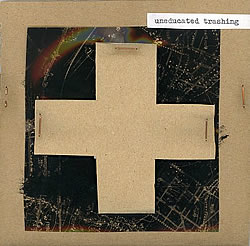 Uneducated
Trashing is Portable Noise Kremator's latest CDr. Wim hand
packaged the very limited edition of 11 copies, and I became the proud owner
of one of them. The Noiseblog
was among the 'sound-art-music' sites dedicating an entry to Michel
Waisvisz' demise. What marked me in this particular entry, is that Wim,
almost in passing, mentioned that until then he had never heard of Michel,
nor of STEIM. He merely read about his death on yet another blog ... (Don't
get me wrong. This is no dissing. I guess most of us are but too well aware
of not knowing a myriad of things, of people and of facts) ...
But what happened next, is that Wim immediately ordered a cracklebox from
STEIM. And then, in two recording sessions each of about one hour, with
his newly acquired kraakdoos and a couple of effects, recorded the 8 tracks
that together make up Uneducated Trashing.
Uneducated
Trashing is Portable Noise Kremator's latest CDr. Wim hand
packaged the very limited edition of 11 copies, and I became the proud owner
of one of them. The Noiseblog
was among the 'sound-art-music' sites dedicating an entry to Michel
Waisvisz' demise. What marked me in this particular entry, is that Wim,
almost in passing, mentioned that until then he had never heard of Michel,
nor of STEIM. He merely read about his death on yet another blog ... (Don't
get me wrong. This is no dissing. I guess most of us are but too well aware
of not knowing a myriad of things, of people and of facts) ...
But what happened next, is that Wim immediately ordered a cracklebox from
STEIM. And then, in two recording sessions each of about one hour, with
his newly acquired kraakdoos and a couple of effects, recorded the 8 tracks
that together make up Uneducated Trashing.
Together it makes for a wonderful tribute.
The CDr's title is also that of a Noiseblog entry dated july 13th, 2008: Uneducated Trashing. Together with a lot of info on Michel Waisvisz and the schematic of a cracklebox, the entry is reprinted as the CDr's inlay. I think you should read it.
"This
is not noise.
The rest is." ( * )
notes __ ::
(*) "The
rest is noise" is the title of a recent 'history of the twentieth century
through its music', by author and New York Times (classical) music critic Alex Ross.
It is also the title of Alex Ross'
blog. [ ^ ]
[ earlier related SB-entry: Michel's Song of Praise ]
tags: cracklebox, kraakdoos, noise
# .270.
comments for « Trashing, uneducated » ::
|
Comments are disabled |
6 min read 🤓
Michel's Song of Praise
july 28, 2008.
Here's a picture of the round table in Radio Aligre's studio during the july 14th edition of Songs of Praise.
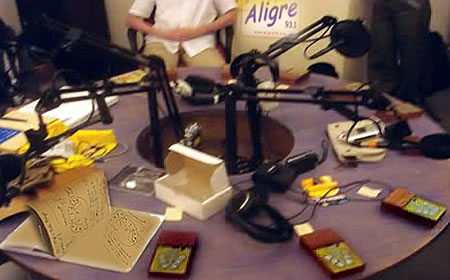
Nine crackleboxes, a double bass and a sopranino sax gathered in the small basement at the rue de Montreuil, Paris X, to perform a Kraakdoos Sinfonietta, dedicated to performer, improviser, inventor and live-electronic-music pioneer Michel Waisvisz, who recently passed away.
The nine crackleboxes (some were shiny new, some had had a busy life performing
and came to be pretty worn) were placed in a half circle on Radio AligreFM's
table, and numbered.
Clockwise.
From 1 to 9.
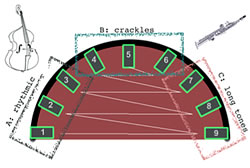 Number 1 was played by Marie Borrel, number 2 by David Steinberg,
3 by Yoko Miura; Rinus van Alebeek played number 4, Silvie
Encrevé did number 5, 6 was in the hands of Rébus, 8 played
by FlexRex, and number 9 was held by Cosmo Helectra.
Number 1 was played by Marie Borrel, number 2 by David Steinberg,
3 by Yoko Miura; Rinus van Alebeek played number 4, Silvie
Encrevé did number 5, 6 was in the hands of Rébus, 8 played
by FlexRex, and number 9 was held by Cosmo Helectra.
Number 7 is missing in this list because the seventh
cracklebox was malfunctioning. It was a 'kapotte kraakdoos' ...
In order to not function, number 7 obviously
didn't require a player.
I liked that idea, and decided to include the 'silent cracklebox' in the performance ...
Each cracklebox is 'unique': each one reacts and sounds differently. Its sound will also differ from player to player, and from time to time, from place to place. It is the player's body that actually 'closes the box's circuit'. Thus - literally - the player's body becomes part of the instrument. If the body changes, so does the instrument.
Therefore the Kraakdoos Sinfonietta started with a short individual
solo (20-40 seconds) of each of the boxes, in some order. (For 'Songs of
Praise' that order was 1-9-2-8-3-7-4-6-5.)
After this, the double bass (Jean Bordé) and sopranino sax (Jean-Jacques
Duerinckx), placed at opposing sides of the table and intended as sort
of a 'counter-voice' to the 'electric ramblings' of the crackleboxes, played
a short duet, that acted as a bridge leading to the main section, where
in the end for several minutes all the crackle-boxeurs played together
...
It are the final minutes of this part that you can hear and see in the u-Tube that Rébus shot (partly during our, and his, performance) ...
I divided the nine boxes into three groups of three. Each group corresponded
to a different characteristic of the sound that each group's players were
asked to generate in the final part of the sinfonietta. There were
a 'cracklings' group, a 'rhythmic' group, and a 'long tones' group.
The three groups entered the final part one after the other. Then all nine
crackleboxes and the two acoustical instruments played together for a couple
of minutes, building up to a sudden, abrupt stop.
That stop then was followed by some 30 seconds of silence.
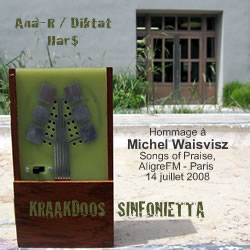 The full recording of the Kraakdoos Sinfonietta, as we performed
it on this year's Bastille
Day in Paris during the Songs of Praise emission dedicated
to Michel Waisvisz, is this entry's podcast. It is a 256 kbps stereo mp3-file,
that you
may download, or listen to by clicking either the 'cover image' to the
left, or the link at the beginning of this entry.
The full recording of the Kraakdoos Sinfonietta, as we performed
it on this year's Bastille
Day in Paris during the Songs of Praise emission dedicated
to Michel Waisvisz, is this entry's podcast. It is a 256 kbps stereo mp3-file,
that you
may download, or listen to by clicking either the 'cover image' to the
left, or the link at the beginning of this entry.
I am really thrilled that this worked out the way it did, and thank all that came to be part of the
10 (wo)men strong 'cracklebox
orchestra' and perform in the small basement housing Radio
AligreFM's studio in the rue de Montreuil, Paris XI.
...
Apart from the Sinfonietta, there was a great many more interesting audio to be heard in this one-and-a-half hour special edition of Songs of Praise. Much of it was pretty unique. (So some of you surely will be interested to download the mp3-file of the full broadcast: a link to that file can be found here.)
Cosmo played the MD-recordings he made at the Ateliers Pratiques Sonores (LAPS) at Mains d'Oeuvres (Saint Ouen), in may 2007, when with his daughter he attended an 'Electro Beep Club', animated by Michel Waisvisz.
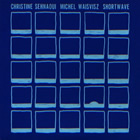 |
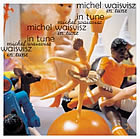 |
We also played tracks from Shortwave, a numbered limited edition
CD published by Al
Maslakh Records, a Lebanese label for improvised and experimental music.
Shortwave has five improvised duets between Michel, playing the
Hands, and french/lebanese saxophone player Christine
Sehnaoui.
The duets were edited from recordings made at the GRM
studios in Paris, in 2007. Shortwave came from the presses on the
morning of the day of Michel's death ( * ). It is
one of the very few albums with studio recordings by Waisvisz that are (still)
available.
Another of these is In Tune, a CD
published in 2005 by the german Sonig
label, specializing in 'experimental, electronic and non genre specific'
musics. In Tune is a compilation of recordings made between 1977
and 2000. Among the nine tracks on the CD
there are three that come from 'Crackle', Michel Waisvisz' vinyl
album released in 1978.
On thursday evening october 18th, 2007 - precisely eight months before
his demise - Michel Waisvisz gave an overview of his work as part of a Test_Lab:
Audio_Ojects event in V2, Rotterdam (the Netherlands). The event in
Rotterdam included demonstrations of audio work in Second Life. Because
conversely the talks and demonstrations that took place in V2 were video-streamed
in Second Life, I could follow Michael's presentation in Paris from behind
my laptop screen.
I remember it very well, as I was pleasantly struck by his presentation that evening, which seemed
particularly inspired. A very personal account, indeed, and
"highly subjective," as he said himself in his
introduction.
But surely that's what most 'good stories' tend to be ...
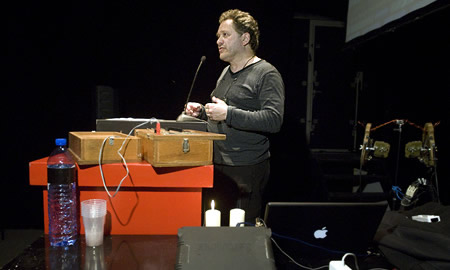
Michel Waisvisz during the Test_Lab:Audio_Objects-event at V2, Institute for the Unstable Media, in Rotterdam (the Netherlands), on the evening of october 18th, 2007. (Photo © 2007, Jan Prij)
In his Rotterdam talk Michel described, pretty much chronologically, his Werdegang. Starting from the, apparently very literal, détournement of the acoustic piano at his parents' house in the 1960s, together with his brother, he gave a fascinating account of his subsequent lifelong quest for novel ways and means to, like in the inside of a piano, touch and handle (electronic) sounds directly: "A keyboard for us was something that belonged in a church. We were into a world where sound could move, and you could navigate in the sound ..."
It was a long talk.
Michel went on much longer already than planned for the evening, but it was not nearly long enough.
He kept running out of time.
For the Songs of Praise emission I made a half hour montage consisting in extracts from this presentation, alternated with, among others, tracks from the Crackle album. Many thanks to Brigit Lichtenegger (Evo Szuyuan), one of the organizers of the Dorkbot sessions in SL, who was so kind as to send me an audio file of Michel's Test_Lab presentation. Thanks of course also to V2.
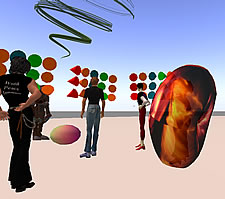 Michel Waisvisz ended his talk in Rotterdam as Pata Mayo - his avatar in
Second Life - and presented the Patafone, a virtual instrument
that he designed and built. It therefore was wonderful that members from
the AOM, the Avatar Orchestra Metaverse, agreed to be in Second Life for
the end of the radio program, and from there contributed to our tribute
to Michel, by improvising - live in SL
- on Pata Mayo's Patafone ...
Michel Waisvisz ended his talk in Rotterdam as Pata Mayo - his avatar in
Second Life - and presented the Patafone, a virtual instrument
that he designed and built. It therefore was wonderful that members from
the AOM, the Avatar Orchestra Metaverse, agreed to be in Second Life for
the end of the radio program, and from there contributed to our tribute
to Michel, by improvising - live in SL
- on Pata Mayo's Patafone ...
Thus the AOM provided a highly appropriate finale ... It was like Michel observed himself at
the very end of his presentation in Rotterdam, when with a mix of pride and surprise he
noticed that "other people are now playing the instrument ... Nice !"
Yes.
Other people now are playing the instruments.
It's like that.
notes __ ::
(*) The CD's
arrived at STEIM in Amsterdam from Beirut just in time for me to be able
to grab a copy (thank you, Minouk) when I passed there on my way back from Berlin to Paris, just
a couple of days before the 14th ... [
^ ]
[ earlier related SB-entry: Michel Waisvisz (1949-2008) ; next related SB-entry: Trashing, un(un(un(educated ]
tags: cracklebox, kraakdoos, songs of praise, michel waisvisz, aom, second life
# .269.
comments for « Michel's Song of Praise » ::
|
Comments are disabled |